Sydney McLaughlin-Levrone will race at the Diamond League final on Friday. Well, sort of. Arguably the best athlete in the world, the 400m hurdles world record holder, will compete in Brussels across two engrossing days of athletics to punctuate the season following a sensational Paris Olympics.
Except the American will not technically be involved in the Diamond League final. That’s because McLaughlin-Levrone has not appeared in the world’s premier track meet all season – she does not qualify for the finale itself, according to the rules, which stipulate she needed to compete in one meet prior to this week.
Instead, the 25-year-old preserved herself throughout the year, bidding to peak in Paris and claim gold, as was her right. And her plan proved to be a masterstroke. Not only did she claim two golds, including the 4x400m relay, she dazzled in a way that elevated her above the event entirely. All while securing her place and becoming the face of Michael Johnson’s Grand Slam Track.
You see, as great as Olympic bronze medalist Femke Bol is, McLaughlin-Levrone owns the 400m hurdles and has simply been competing against herself in recent years. The titanic showdown with Bol, built up for months by many before Paris, not only failed to materialise, but the chasm between the athletes made the discussion immaterial.
A sizzling time of 50.37 seconds, 1.5 seconds ahead of compatriot Anna Cockrell and 1.78 seconds clear of Bol, reimagined the potential to glide over the barriers at breathtaking speed. World Athletics president Lord Seb Coe even floated the idea of raising their height of the hurdles to provide a sterner test of McLaughlin-Levrone, who by now is well-established as an outlier in this era. Her performance at the Stade de France would see her fall just two tenths of a second shy of qualifying for the final of the flat 400m.
So her stardom has forced organisers to reevaluate the rules, desperate to include her in the final and further legitimise the event.
Except, McLaughlin-Levrone will not race her preferred event, instead it appears she is beginning to experiment and transition towards another challenge, to further cement her athletic legacy.
Her first exhibition sees her run in the 400m flat on Friday, then the 200m on Saturday. But McLaughlin-Levrone will once again be racing against herself, it seems, with Friday’s best opponent, on paper at least, Jamaica’s Stacey-Ann Williams, who holds a season’s best 1.25 seconds slower than the American’s season’s best of 48.75 seconds. That event takes place 11 minutes before the actual Diamond League final, starring Olympic champion Marileidy Paulino. A mouthwatering prospect that will have to wait for 2025 at least.

While Saturday’s 200m, 24 minutes before Sha’Carri Richardson and Daryll Neita compete in the 200m final, pits McLaughlin-Levrone against the likes of Slovenia’s Maja Mihalinec Zidar and Belgium’s Rani Rosius, both more than seven tenths of a second slower than the American’s best of 22.07 seconds.
“I went to Greece with my husband to relax for a week,” said McLaughlin-Levrone. “It was necessary after those fantastic Olympics, which I worked towards for so long.
“I feel enormously grateful for what I was able to experience in Paris. After that, we returned to Los Angeles. But because I still feel physically and mentally fresh, I wanted to run one more meeting to finish the season.”

The two-day meet in the Belgian capital has provided a glimpse of the sport’s future, something already experienced in other sports, such as golf, with the world’s best players, operating as ‘independent contractors’, now divided outside of the four majors for more than two years.
While McLaughlin-Levrone is a welcome addition, in any capacity, this weekend, the conspicuous absence of Grant Holloway, the Olympic 110m hurdles champion, and Josh Kerr, the 1,500m world champion, point to the increasingly-likely prospect of a divided sport in the coming years.
Holloway said on Wednesday: “I will not be participating in the Brussels Diamond League Final due to a failure to reach agreements on the terms of my participation between my team and the meeting directors of the Diamond League. Shame that they doing athletes like that #NeverCompeteForLess.”
Kerr, meanwhile, will have his feet up, having already called time on his season after opting to race the 5th Avenue Mile in New York, where he shattered a 43-year record in a quite stunning 3mins 44.3secs. The allure of the Big Apple, closer to his home in New Mexico, and a sizeable appearance fee was enough for the Briton to snub racing rival Jakob Ingebrigtsen once more in Zurich and Brussels.

All of which is to say the sport might be heavily reliant on Olympic legend Johnson’s new, compelling way. The American believes he can compensate athletes and deliver their “true worth” with Grand Slam Track, with a promise of $12.6m (£9.6m) in prize money next year. Yet its success may depend on every event delivering a near-complete field.
Kerr has signed up with the entire 1,500m Olympic podium, gold medalist Cole Hocker and bronze medalist Yared Nuguse. Yet without Ingebrigtsen, each race will feel incomplete to many, no matter how regularly we see these stars meet head-to-head outside of the major meets. The Diamond League and World Athletics, with the new Ultimate Championship, will inject more prize money into the sport too, likely forcing athletes to pick and choose when to feature.
So get ready for two days of engrossing athletics in Brussels across many disciplines, but who you see, and crucially who you do not see, point to the sport’s revolution in 2025 and beyond.














